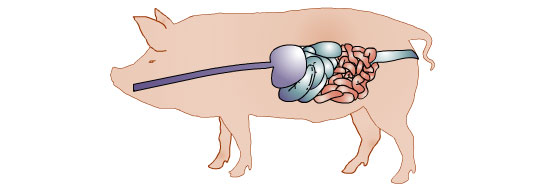Bases of the problem
The stomach of the pig is characterized by its great fragility, in particular in the pars esophageal zone close to the cardiac region. This region of the stomach is characterized by the stratified squamous nature of the epithelium lining and the lack of secretions, which make it very vulnerable to any external aggression. The most apparent lesion is parakeratosis of diverse degrees accompanied by yellowish tinction of the mucosa due to bilious contamination. If the process continues then deeper erosions appear, there are losses of blood (white pigs) and deaths. Three common characteristics in pigs with ulcers are:
1) fluid contents in the stomachThe appearance of ulcers seems to be related to the increase of hydrochloric acid secretion by the parietal cells of the gastric glands together with a reduction of the protection against the autodigestion of the gastric mucosae.
2) reduced pH
3) high pepsine activity

Gastric ulcers are characterized by their dynamic nature, appearing and healing until disappearing in the space of a few hours. The incidence has increased in recent years probably in relation to the development of new genetic lines, the more aggressive standards of management, and the establishment of alimentation programs based on diets that do not take the harmonious development of the digestive system into account. Among the exogenous factors to be considered, genetics and digestive physiology play an important role. So, the pressure for selection of fast growth of lean seems to increase the incidence. In fact, it has been estimated that the inheritability of gastric ulcers is approximately 0.52. The second group of factors includes alimentation and the presence of pathologic processes that affect the digestive mucosa, modify the alimentation models or damage the immunity and the physiologic development of the animal. In the same way, stress, whether caused by high temperatures, unsuitable densities, poor availability of feeders and drinkers or erratic alimentation, can accelerate and intensify the process. In fact, the incidence of problems is greater in higher integrations or nuclei of large finishing herds than in smaller nuclei (different management?).




